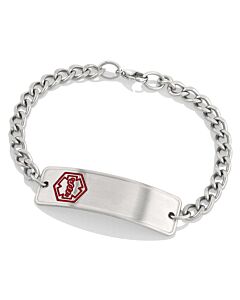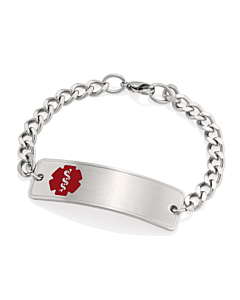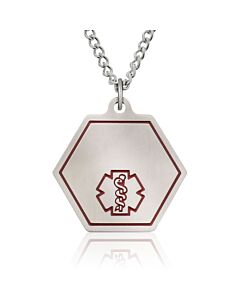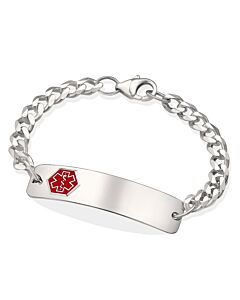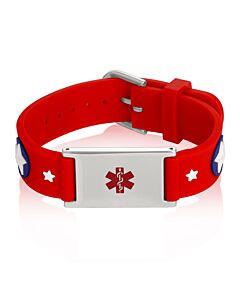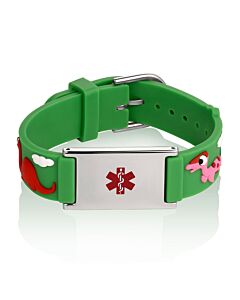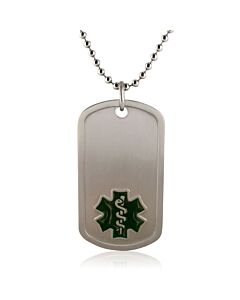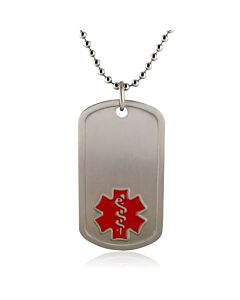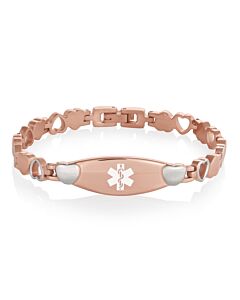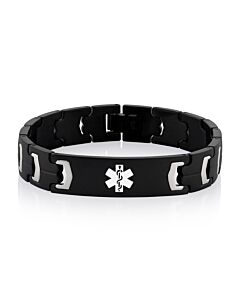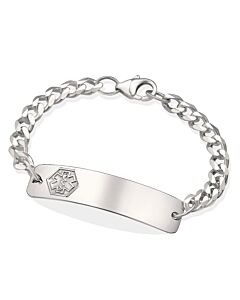

Medical IDs for Blood Clots VTE, DVT, and PE
Blood clots are a serious medical condition that affect as many as 900,000 Americans each year. Also known as Venous Thromboembolism (VTE), blood clots can be classified into two other categories: Deep Vein Thrombosis (DVT) and Pulmonary Embolism (PE). Since a blood clot is a condition that isn’t visible, it is recommended to wear a medical ID bracelet or necklace to alert medical professionals in an emergency.
DVT is a blood clot located in a deep vein, usually in a leg or arm. If left untreated, a DVT can move or break apart and travel to the lungs. A blood clot that travels to the lung is a PE, and it can be life-threatening, requiring immediate medical attention. Statistics show that an estimate of 100,000 people die of blood clots and it can happen to anyone.
Communicating Blood Clot, Blood Clot Risks, and Medications in an Emergency
According to the CDC, early diagnosis of a blood clot is critical to prevent death. A medical ID can easily help identify or alert emergency personnel of a blood clot and its risks, even when a patient has become unconscious or unable to speak. Study shows that 3 in 10 people who have a blood clot will have another episode in 10 years.
Symptoms of a blood clot in the leg or arm can include:
- Swelling
- Pain
- Tenderness
- Redness of the skin
Symptoms of a life-threatening blood clot in the lung can include:
- Sudden shortness of breath
- Chest pressure
- Difficulty breathing, seeing, or speaking
- Unconsciousness or passing out
- Blood clots can travel to the arteries or veins and can cause heart attack, stroke, or damage to organs.
Talk to your doctor or seek immediate medical treatment if you think you might have a blood clot. Blood clots are serious, and a blood clot in the lung is a medical emergency. Hence, it is recommended to wear a medical ID bracelet or necklace when diagnosed with a blood clot, an increased risk of a blood clot, or a history thereof.
Anticoagulant medications also referred to as blood thinners are commonly used to treat and prevent blood clots. It is important to alert emergency personnel or responders if a person is taking blood thinners to avoid the risk of bleeding. This information can be custom engraved on a medical ID along with other crucial health information.
What to Engrave on a Blood Clot Medical ID


Blood clots are a serious medical condition that emergency and health professionals should be alerted of. Every person and blood clot are different hence, it is recommended to choose a personalized medical alert jewelry that can hold the wearer’s unique and specific medical information. This can include the following:
- Your Name to quickly identify yourself in an emergency
- History of medical conditions including the type of blood clot. Examples: DVT, PE, heart attack or stroke.
- Specific name of medications. Examples: anticoagulants, heart medications, aspirin, or insulin.
- Blood type
- Emergency contact number. This can be your family or doctor’s contact information.


“As with any medication, there are risks that come along with taking blood thinners. One of those risks is unwanted or uncontrolled bleeding…When I started thinking about all of the ways I could be injured without someone there to help me, or without someone who knew me, I realized that a medical ID was an essential part of caring for myself after a blood clot.” – Sara Wyen, VT and PE blood clot survivor, Blood Clot Recovery Network
Our Blood Clotting Disorder Medical Bracelet & Wristband Options for Adults
Shop our collection of medical ID bracelets designed for full customisation, allowing you to engrave vital medical information such as a blood clotting disorder, medication details, and more. Shop many different styles and metal types to select the right ID for you!
Blood Clot Medical Alert Bracelets for Kids
When shopping for a medical ID bracelet for children, we have you covered from toddler up to teen. Choose from many different styles, from classic to colorful and creative, all while keeping peace of mind in emergencies.
Our Blood Clotting Medical ID Necklace Options
If you prefer a necklace as your medical ID, there are many options from rugged to refined. Pick a necklace that will work for your everyday wear, whether that is tough stainless steel or luxurious gold!
Featured/Best-Selling Blood Clotting Alert Jewellery
If you want to just shop our best selling blood clotting alert jewellery, here is a short list.
Frequently Asked Questions
Should I wear a medical alert bracelet for blood clotting disorders?
Yes, since a blood clotting disorder is an invisible condition, it is recommended to wear a medical ID bracelet or necklace to alert medical professionals in an emergency. This is especially important if the condition or medication would alter the best treatment for you in a situation where you or a loved one cannot advocate for yourself.
What is the medical blood clot symbol?
There is no universal blood clotting symbol so it is best to accurately describe any condition, medication, and additional pertinent medical information on your ID. Example: “Medicine: Warfarin” and any relevant dose or medicine location information.
Should I still carry a blood clot alert card if I wear a blood clot bracelet?
It is a good idea to carry an expandable wallet card (blood clot alert card) that provides additional details on top of your medical ID bracelet or necklace. Since it is in your wallet, a bracelet or necklace is still needed, but the expandable wallet card will allow for more medical information to be carried with you at all times.



 - US
- US  - Canada
- Canada  - Australia
- Australia 
